Concept of False Information under IPC – Section 202 – 211 IPC

By Tania Maria Joy
Introduction
Evidence is every type of proof legally presented at trial (allowed by the judge) that is intended to convince the judge and/or jury of alleged material facts of the case. Evidence is any statement required or permitted by the court on oath and any document which is produced by the court’s instruction. As per Section 3 of the Indian Evidence Act, the evidence is of two types;
- Oral
- Documentary Evidence
A statement or documentary evidence presented to the court when known to be false or is believed not to be true is false evidence. Criminal evidence is any physical or verbal evidence that is presented for the purpose to prove a crime.
Essential Ingredients of False Evidence
False evidence made by a person who is:
- Bound by oath, or
- By an express provision of law, or
- A declaration which a person is bound by law to make on any subject, and
- Which statement or declaration is false and which he either knows or believes to be false or does not believe to be true.
Three essential prerequisite conditions for the application of Section 191:
- A legal obligation to state the truth,
- Making of a false statement or declaration, and
- Belief in its falsity.
Perjury has been kept at the position of criminal form under English Law of Perjury because a person is at the guilt by the statutory obligation of the crime if lawfully sworn as a witness or as an interpreter in a judicial proceeding where he lawfully makes a statement material in that proceeding which is known to be false or does not believe it to be true.
The violation of oath is a condition prerequisite. Under Indian law, a statement contrary to oath /declaration requires an express provision to state the truth.
Under English Law, a false statement is a statement or a declaration falsely made only in a judicial proceeding whereas, under Indian law false evidence is a statement when given to a public servant would also be classified as Perjury.
Essentials of fabricating false evidence
- Cause any circumstances to exist; or
- Makes any false entry in any book or record etc containing a false statement ;
- Intending that such circumstances, false entry or false statement may appear in evidence in a:
a) Judicial proceeding, or
b) In a proceeding taken by law before a public servant,
c) Before an arbitrator; and
4) Helps form an opinion upon the evidence, to entertain an erroneous opinion;
5) Touching any point material to the result of such proceeding.
An intention that Fabricated Evidence May Appear as evidence in a judicial proceeding
Intention plays a very vital role in Section 192. False documents so made should appear in evidence in a judicial proceeding or before a public servant or arbitrator.
Dy.GM, ISBT Vs Sudarshan Kumari
An oath was taken in this case which was taken on the name of a notary which does not exist so it was said that it was a clear violation of Section 199 of the Indian Penal Code.
Use of False Declaration
A Declaration or statement which a person gives in front of the court is false or believes not to be true is punished Section 200. A person who corruptly uses or attempts to use as true any such declaration, knowing the same to be false in any material point, shall be punished in the same manner as if he gave false evidence.
Offences Against Public Justice
Section 201 to 229A explains offences against public justice which is described further.
Causing the Disappearance of Evidence
There are two categories:
- Causing disappearance
- False information
There both intentions are to screen the offender. Suppose there are two friends A and B. A has murdered X and to hide the body of X and to protect A from the charges B helps him so it falls under Section 201 because of causing the disappearance of evidence. B has the intention to screen the offender.
Section 201 deals with two aspects:
Causing disappearance of evidence.
Giving false information about the offence.
Ingredients of Section 201
- The offence must have been committed.
- Accused must cause the disappearance of the evidence concerning the offence committed.
- Gives false information about the offence( accused knowns this to be false).
- Intention- to screening the offender from legal punishment.
Commission of Offence
Commission of offence is sine non qua that is it is an essential condition or a thing that is necessary.
Palvinder Kaur vs the State of Punjab– In this case, the wife murdered the husband with her boyfriend due to her extramarital affair with him. So the wife and her boyfriend have put the husband’s body in the trolley and throw it into the well. After one month when his body was found in post mortem only Potassium cyanide is found and nothing else. They both are charged under Section 302 and 201. But no evidence can prove to the prosecution that the murder is done by his wife with the help of his boyfriend. So the outcome was that as the principal offence under Section 302 was unable to establish due to which consequently under Section 201 was not establish either because the commission of an offence is sine non qua( essential condition).
Omission to Give Information
Section 202 states that Intentional omission to give information of offence by a person bound to inform. For example, a police officer is going for his duty from his home to the police station. On his way, he saw that there was a crowd and they all were beating a person. When he inquired he comes to know that the person has stolen something from a shop so that’s why they all were beating but he did not take any action and went away so he would be charged under section 202 because it was his responsibility, legal duty, the statutory obligation under Criminal Procedural code, to report any cognizable offence when it comes under his knowledge and he should take any action.
Ingredients of Omission to give information
1) There should be knowledge or reasons to believe that an offence has been committed.
2) The person should intentionally omit to give any information regarding that offence.
3) The person is legally bound to give still he omits to give information.
4) He shall be punished with imprisonment of either description for a term which may extend to six months or with a fine or with both.
Intentional Omission to Give Information
There are many times Bonafide mistakes are done that are with utmost good faith. So at that time, the intentional omission is avoided if they are committed with a bonafide mistake.
Harishchandra Singh Sajjan Singh Rathod Vs State of Gujarat
It was a case related to Judicial torture in which a police officer has kept a person in judicial custody and had given torture due to which he has got many injuries so police office has sent him to a nearby hospital but till the time the person could reach the hospital. He died and the case was charged under 304(2) i.e culpable homicide not amounting to murder but Supreme Court held that culpable homicide is not applicable because of two reasons first is a commission of offence has not been established and a second the legal duty to report the offence and intentional omission were not there.
Legal Obligation to Give Information
There should be a legal obligation to give information then only Section 202 will be a trigger. Until and unless there is no legal obligation to give information a person cannot fall under Section 202.
Giving False Information About an Offence
Section 203 is giving false information respected an offence committed that is:
1) Whoever knowing or having reason to believe that an offence has been committed.
2) Gives any information respecting that offence.
3) Which he knows or believes to be false.
4) Shall be punished with imprisonment of either description for a term which may extend to two years or with fine or with both.
For example, A person ‘X’ has made complain in a police station that in his house 10 lakh of jewellery, TV and any other movable property had been stolen although TV and other property were stolen he had given false information related to 10 lakh jewellery. He will be charged under Section 203.
Ingredients of Section 203
1) The offence has been committed.
2) Accused know or he had reason to believe that such an offence has been committed.
3) He gave the information to that offence.
4) The information so given was false and
5) When he gave such information he knew or believed it to be false.
The offence under Section 203 is non-cognizable, but a warrant may issue in the first instance. It is bailable but not compoundable and triable by any Magistrate. Sections 201, 202 and 203 are related but different. All these three sections deal with various aspects of offences dealing with the conduct of a person after the commission of the offence.
Impersonation Abuse of Process of Court of Justice
It is related to the procedural aspect of a criminal proceeding. Section 206 to 210 deals with limited things only. For example, your home in Delhi and the court had given orders to seize the property so to save your home you have agreed with a third party X and sell it to X with the intention that the court cannot seize your home and you can say that it is not your property and it belongs to X, then the person will be liable under Section 206.
Now if in the same example X had taken Dhruv’s property so that he can save his property from fortified seizure and he can return his property after some time then X will be charged under Section 207 and Dhruv will be charged under Section 206.
Section 208:
Fraudulently suffering decree for sum not due. Suppose there is the movable property of 10 lakh that is car and anubhav had taken a loan from a bank to buy a car and now he is unable to pay EMI of the car and therefore the company had sent notice to him that either he pays EMI to them or his car would be seized. but anubhav had refused to pay so the company had taken notice from the court of justice. Now anubhav said to her friend Simran to file a case against him of Rs 11 lakh and anubhav fraudulently lost the case and asked that Simran can take her car and she took it so that it can be saved from the company and after sometime when the case would be closed he will take his car and give some money to her, therefore, anubhav will be charged under section 208.
Section 209
Dishonesty making a false claim in court. Whoever making fraudulently or dishonestly a false claim in court to injure or annoy a person. The punishment is imprisonment of two years and shall also be liable to a fine.
Section 210
Fraudulently obtaining a decree for a sum not due. In the above example, Simran will be charged under section 210.
Conclusion
False evidence is information given by a person to divert the verdict in a court case. False evidence is also known as forged, fabricated, tainted evidence. The intention to give false evidence is to procure the conviction and to make the innocent guilty. Section 191 explains about giving false evidence and section 192 explains about fabricating false evidence. Chapter 11 of the Indian Penal Code has set out the provision relating to giving and fabricating false evidence and offences against public justice.







